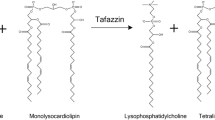Abstract
Barth syndrome (OMIM #302060) (BTHS) is an X-linked disorder of lipid metabolism characterized by skeletal myopathy, neutropenia, growth delay, and cardiomyopathy. It is caused by mutations in the tafazzin gene (TAZ), which lead to decreased production of an enzyme required to produce cardiolipin, a component of the inner mitochondrial membrane necessary for proper functioning of the electron transport chain. The most common initial presentation of BTHS is significant heart failure due to cardiomyopathy, which is the main cause of death in infancy or childhood. On the other hand, some patients have limited clinical features of BTHS. These patients may be overlooked or misdiagnosed with unclassified congenital myopathy, especially when heart failure is not clinically significant. However, these patients could also develop significant heart failure or life-threatening arrhythmias during or even after childhood. Heart failure in BTHS is often responsive to standard medical therapy, indicating early diagnosis is critical. Diagnostic clues of BTHS in the subclinical stage of heart failure include family histories, findings of lipid storage myopathy in the skeletal muscle biopsy, and elevated plasma brain natriuretic peptide levels. The genetic analysis of TAZ is the only confirmatory method for the diagnosis of BTHS. Conclusion: physicians should be aware of the possibility of this disease and carry out genetic studies when it is considered.

Similar content being viewed by others
References
Ades LC, Gedeon AK, Wilson MJ et al (1993) Barth syndrome: clinical features and confirmation of gene localisation to distal Xq28. Am J Med Genet 45(3):327–334. doi:10.1002/ajmg.1320450309
Adwani SS, Whitehead BF, Rees PG et al (1997) Heart transplantation for Barth syndrome. Pediatr Cardiol 18(2):143–145
Barth PG, Scholte HR, Berden JA et al (1983) An X-linked mitochondrial disease affecting cardiac muscle, skeletal muscle and neutrophil leucocytes. J Neurol Sci 62(1–3):327–355
Barth PG, Valianpour F, Bowen VM et al (2004) X-linked cardioskeletal myopathy and neutropenia (Barth syndrome): an update. Am J Med Genet A 126A(4):349–354. doi:10.1002/ajmg.a.20660
Barth PG, Wanders RJ, Vreken P et al (1999) X-linked cardioskeletal myopathy and neutropenia (Barth syndrome) (MIM 302060). J Inherit Metab Dis 22(4):555–567
Bione S, D'Adamo P, Maestrini E et al (1996) A novel X-linked gene, G4.5. is responsible for Barth syndrome. Nat Genet 12(4):385–389. doi:10.1038/ng0496-385
Bleyl SB, Mumford BR, Thompson V et al (1997) Neonatal, lethal noncompaction of the left ventricular myocardium is allelic with Barth syndrome. Am J Hum Genet 61(4):868–872. doi:10.1086/514879
Cantlay AM, Shokrollahi K, Allen JT et al (1999) Genetic analysis of the G4.5 gene in families with suspected Barth syndrome. J Pediatr 135(3):311–315
D'Adamo P, Fassone L, Gedeon A et al (1997) The X-linked gene G4.5 is responsible for different infantile dilated cardiomyopathies. Am J Hum Genet 61(4):862–867. doi:10.1086/514886
Gedeon AK, Wilson MJ, Colley AC, Sillence DO, Mulley JC (1995) X linked fatal infantile cardiomyopathy maps to Xq28 and is possibly allelic to Barth syndrome. J Med Genet 32(5):383–388
Hauff KD, Hatch GM (2006) Cardiolipin metabolism and Barth syndrome. Prog Lipid Res 45(2):91–101. doi:10.1016/j.plipres.2005.12.001
Houtkooper RH, Rodenburg RJ, Thiels C et al (2009) Cardiolipin and monolysocardiolipin analysis in fibroblasts, lymphocytes, and tissues using high-performance liquid chromatography–mass spectrometry as a diagnostic test for Barth syndrome. Anal Biochem 387(2):230–237. doi:10.1016/j.ab.2009.01.032
Ichida F, Tsubata S, Bowles KR et al (2001) Novel gene mutations in patients with left ventricular noncompaction or Barth syndrome. Circulation 103(9):1256–1263
Johnston J, Kelley RI, Feigenbaum A et al (1997) Mutation characterization and genotype–phenotype correlation in Barth syndrome. Am J Hum Genet 61(5):1053–1058. doi:10.1086/301604
Kelley RI, Cheatham JP, Clark BJ et al (1991) X-linked dilated cardiomyopathy with neutropenia, growth retardation, and 3-methylglutaconic aciduria. J Pediatr 119(5):738–747
Kulik W, van Lenthe H, Stet FS et al (2008) Bloodspot assay using HPLC-tandem mass spectrometry for detection of Barth syndrome. Clin Chem 54(2):371–378. doi:10.1373/clinchem.2007.095711
Liang WC, Nishino I (2011) Lipid storage myopathy. Curr Neurol Neurosci Rep 11(1):97–103. doi:10.1007/s11910-010-0154-y
Neuwald AF (1997) Barth syndrome may be due to an acyltransferase deficiency. Curr Biol 7(8):R465–R466
Schlame M, Kelley RI, Feigenbaum A et al (2003) Phospholipid abnormalities in children with Barth syndrome. J Am Coll Cardiol 42(11):1994–1999
Schlame M, Towbin JA, Heerdt PM et al (2002) Deficiency of tetralinoleoyl-cardiolipin in Barth syndrome. Ann Neurol 51(5):634–637. doi:10.1002/ana.10176
Spencer CT, Bryant RM, Day J et al (2006) Cardiac and clinical phenotype in Barth syndrome. Pediatrics 118(2):e337–e346. doi:10.1542/peds.2005-2667
Spencer CT, Byrne BJ, Gewitz MH et al (2005) Ventricular arrhythmia in the X-linked cardiomyopathy Barth syndrome. Pediatr Cardiol 26(5):632–637. doi:10.1007/s00246-005-0873-z
Stein SM, Dale DC (2003) Molecular basis and therapy of disorders associated with chronic neutropenia. Curr Allergy Asthma Rep 3(5):385–388
Steward CG, Newbury-Ecob RA, Hastings R et al (2010) Barth syndrome: an X-linked cause of fetal cardiomyopathy and stillbirth. Prenat Diagn 30(10):970–976. doi:10.1002/pd.2599
Conflict of interest
The authors declare that they have no conflict of interest to report.
Author information
Authors and Affiliations
Corresponding author
Rights and permissions
About this article
Cite this article
Takeda, A., Sudo, A., Yamada, M. et al. Eponym. Eur J Pediatr 170, 1365–1367 (2011). https://doi.org/10.1007/s00431-011-1575-6
Received:
Accepted:
Published:
Issue Date:
DOI: https://doi.org/10.1007/s00431-011-1575-6




